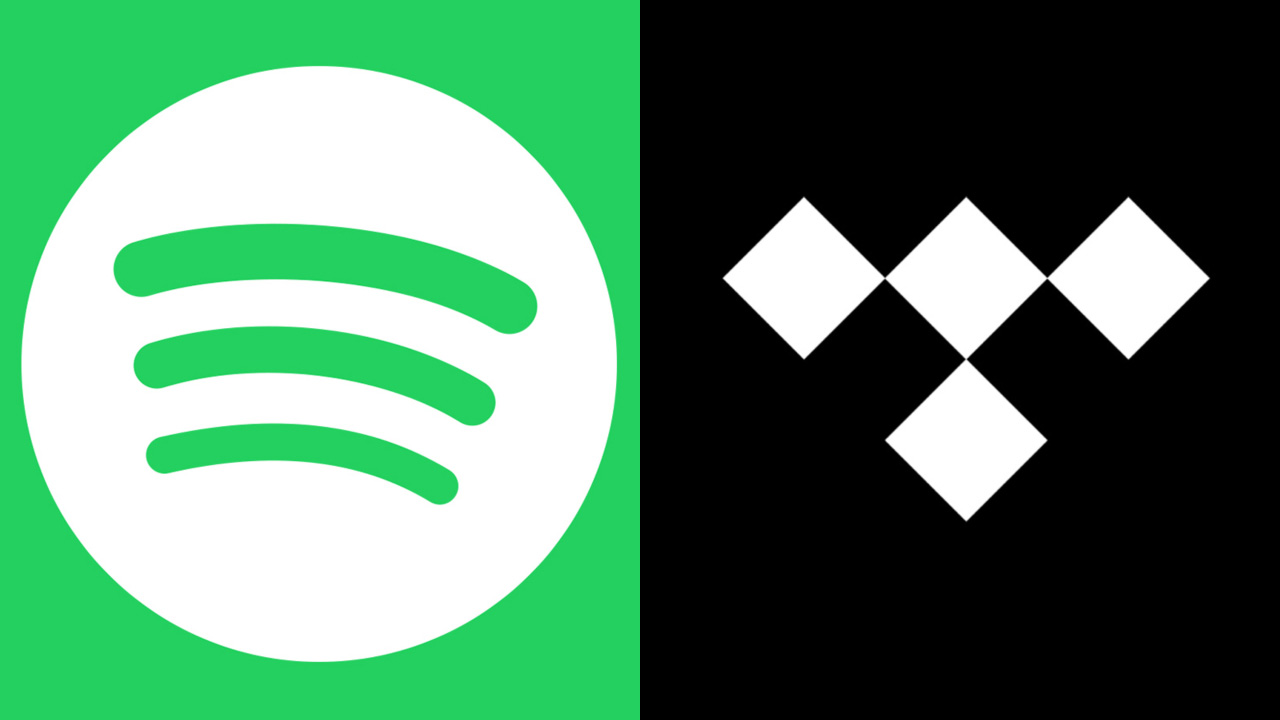One is an 800-pound media colossus, the other an opinionated champion of high-res music - but enough about Joe Rogan and Neil Young. Music streaming rivals Spotify and Tidal are also facing off in a battle to secure new subscribers.
Spotify is the grandpappy of music streaming services and offers class leading music curation and catalogue depth, but when it comes to sheer musical fidelity, Tidal puts up a compelling counter argument.
Time to unpick the benefits and shortfalls of each, and decide which is the best streaming service for you and all your lolly.
Spotify vs Tidal: At a glance
Spotify
- Price: $9.99/£9.99 monthly, $12.99/£12.99 (Duo), $4.99/£4.99 (student tier) or $14.99/£14.99 (family tier)/monthly
- Sound Quality: 96kbps- 320kbps
- 3D audio: No
- Sign up at Spotify
- Read our full Spotify review
Tidal
- Price: $9.99/£9.99 monthly or $19.99/£19.99 monthly (high quality HiFi Plus tier)
- Sound Quality: 320kbps, CD quality, 24-bit/96kHz High Res MQA encoded
- 3D audio: Yes
- Sign up at Tidal
- Read our full Tidal review
When it comes to audio fidelity and format choice, Tidal smokes Spotify. Not only does it offer better than CD audio but immersive Dolby Atmos mixes too. Catalogue depth is impressive, while discovery and curation tools are top notch. But to enjoy its higher resolution presentation you’ll need to be prepared to dig deep for its HiFi Plus tier.
Spotify is the king of the streaming music market and wears the crown for one very good reason - it's a pleasure to use. Audio quality is good provided you pay (320kbps), but it’s not going to reward owners of high-res headphones and audiophile kit. If you opt for the ad-supported free version of Spotify, audio quality can be as low as 96kbps, which sucks.
Spotify vs Tidal: Musical offering

Both Spotify and Tidal boast exhaustive music catalogues: Spotify claims more than 70 million tracks, while Tidal boasts 80 million. You’ll be hard pressed to find even the most eclectic of metal and prog missing from either. That’s not to say the catalogues are identical, but they’re so evenly matched hunting for differences is akin to looking for a needle in a mosh pit.
Whether your tastes are classic rock, metal, punk, prog, alternative, pop or jazz, you’ll be well catered for.
The content recommendation algorithms of both Spotify and Tidal are impressive. Play Korpse’s Retaliation on Spotify and the service points you in the direction of Traumatomy and Extermination Dismemberment. Spin the same on Tidal, and you’ll be served Autopsychosis and Megalodon. We’ll take either.
Similarly, both services offer the titular debut by Canadian punks Billy Talent, but here’s the rub - Tidal has it as an MQA Master stream, with more bits to get your teeth into.
Tidal’s navigation could probably be more tailored. While the service knows full well the depths and depravity of my musical tastes, it still suggests new tracks from Queen Naija. Perhaps the algorithm has a sense of humour?
Arguably the biggest difference between the two services boils down to non-music content. As evidenced by the $100 million contract that exclusively secured Joe Rogan’s podcast, Spotify is increasingly looking to dominate the lucrative podcast market – and its exclusivity deals may enough to sway you. A recent partnership with DC means there are original big budget Batman stories coming, and I’m well up for that.
Spotify vs Tidal: Prices
Spotify
When it comes to accessibility, Spotify has it nailed. You can listen for free, provided you can live with ads. Spotify Premium costs $9.99/£9.99 a month, with a Duo tier that supports two users for $12.99/£12.99. Its Family Tier is priced at $14.99/£14.99. Opt for the latter and up six people can have their own account. A Student Tier allows you to split the Premium sub.
Tidal
Tidal HiFi has a comparable monthly charge, but you can’t access hi-res streams. The Tidal Hi-Fi Plus tier, at $19.99/£19.99 per month, opens the door to High-Resolution MQA (Master Quality Authenticated) Master files, and immersive spatial audio mixes. Streaming quality doesn’t get better.
Spotify vs Tidal: Usability and interface

Spotify has the science of usability down to a fine art. With collaborative playlists, excellent content curation and useful new release updates, it always feels nice and comfy.
The Home page showcases your podcasts and Recently Played, and as you scroll down you’ll find playlists and mixes. Spotify knows what you like, and you’ll find something to listen to in seconds. You can also share Spotify content on Instagram and Facebook, which is cute.
Tidal is a more overt musical proposition; podcasts occupy far less real estate. You do have to make more of an effort to find fresh fodder though, scrolling someway down before you hit new album suggestions and playlists.
Audiophiles will appreciate the emphasis Tidal gives to MQA mastered content and playlists.
Spotify vs Tidal: Audio quality
So far, it seems like semantics are all that really separate Spotify and Tidal, but there’s a tangible gulf between the two when it comes to audio quality.
Spotify sounds fine in isolation, but doesn’t (yet) offer any 24-bit hi-res audio content, and despite hinting at its arrival, the service has so far been unable to put a delivery date on higher quality streams.
As a result, Spotify Premium maxes out at 320kbps. For everyday use, on everyday headphones, this is fine.
Much like Suggs, Tidal goes one step beyond. Pay for its HiFi Plus subscription tier and you’ll open the door to high-res MQA studio audio, distinguished by a ‘Master’ flag next to each track.
Tidal Hi-Fi Plus streams up to 24-bit/96kHz, with MQA (Master Quality Authenticated) encoding. Listen on high quality, hi-res audio headphones and you’ll hear greater resolution with more dramatic dynamics. Tracks can exhibit a greater level of space; instruments get more air to breathe. Of course, not every song sounds appreciably better, as other factors come into play, but you get the gist.
Remember though that not every new metal and rock release comes in hi-res. Crisis Of Faith, the new Billy Talent album isn’t 24-bit on Tidal. Neither is Scar Weaver by Once Human. But if the playful pipes of Jethro Tull are more your style, The Zealot Gene is on Tidal in all its MQA studio quality frippery.
Spotify vs Tidal: Verdict
Whether your poison is podcasts or Bret Michaels, Spotify doesn’t disappoint. It’s brilliant value for a tenner, and offers excellent music recommendations. But if you’re an audiophile at heart, Tidal’s HiFi Plus tier is worth the premium. Its MQA hi-res tracks sound seriously fine. Just make sure your headphones are up to the job. If they’re not, we have some suggestions for you right here…
Related buyer's guides
- Spotify review: We examine the popular streaming service
- Tidal review: Music streaming with a difference
- Apple Music vs Amazon Music Unlimited: We put them head to head
- Apple Music review: Can Apple take a bite out of the competition?
- Best music streaming services 2022: how do they compare?
- Lossless audio streaming: Is it worth it?
- The best headphones for music: Take your listening to a new level
- Our guide to the best budget wireless headphones: Listen for less
- The best over-ear headphones: Sonic comfort for your ears
- We pick out the best in-ear headphones: Perfect for commuting

